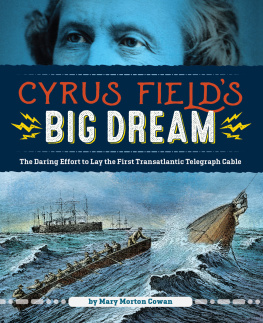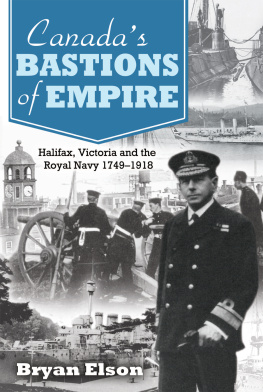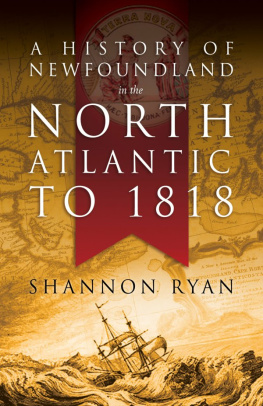Connecting
the
Continents
Hearts Content and the Atlantic Cable
2009, Ted Rowe

We gratefully acknowledge the financial support of the Canada Council for the Arts, the Government of Canada through the Book Publishing Industry Development Program (BPIDP), and the Government of Newfoundland and Labrador through the Department of Tourism, Culture and Recreation for our publishing program.
All rights reserved. No part of this work covered by the copyrights hereon may be reproduced or used in any form or by any meansgraphic, electronic or mechanicalwithout the prior written permission of the publisher. Any requests for photocopying, recording, taping or information storage and retrieval systems of any part of this book shall be directed in writing to the Canadian Reprography Collective, One Yonge Street, Suite 1900, Toronto, Ontario M5E 1E5.
Cover Design by Todd Manning
Layout by Joanne Snook-Hann
Maps and original illustrations by Albert W. Taylor
Cover photo courtesy of Claude Rockwood
Printed on acid-free paper
Published by
CREATIVE PUBLISHERS
an imprint of CREATIVE BOOK PUBLISHING
a Transcontinental Inc. associated company
P.O. Box 8660, Stn. A
St. Johns, Newfoundland and Labrador A1B 3T7
Printed in Canada by:
TRANSCONTINENTAL INC.
Rowe, Ted
Connecting the continents : Hearts Content and the Atlantic cable / Ted Rowe.
ISBN 978-1-897174-42-5
1. Transatlantic cables--History. 2. Telegraph--Newfoundland and Labrador--History. 3. Telegraph stations--Newfoundland and Labrador--Hearts Content--History. 4. Hearts Content (N.L.)--History. I. Title.
TK5611.R69 2009 384.109718 C2009-900593-X
Connecting the Continents
Hearts Content and the Atlantic Cable
Ted Rowe

For: Maureen
and
John
Michael
Christopher, Asta &
Rama Alexander
David
Andrew
You are my life.
Foreword
Growing up in Hearts Content in the 1950s, unless your father worked at the cable station you probably never got to see inside the door. I remember going there twice. The first time I was eleven and curious to find out what went on in the old red-brick building off limits to all but a few. I nagged my father until he took me in one Wednesday afternoon when our store was closed for the weekly half-holiday. The men on duty were delighted to welcome visitors and well accustomed to the tour routine. We went into the one-room library, with its polished reading tables and more books stacked in the floor-to-ceiling bookcases than I had ever seen. I saw the billiard room with the heavy old green-baize table and the card room where the men played poker after hours. I was in awe of the array of equipment clicking and humming away in the office, especially when one of the operators had me stand by a machine to see a message welcoming me to the station print out like magic on a ribbon of paper tape. I held on to it as a keep-sake for years after.
My second visit was in 1961, on a tour arranged for a group of us in the final year of high school. This time it was more formal, as the staff pointed out how the messages came into the station and passed through the automatic regenerating equipment on their way to New York. We encountered the old-style decorum of the place head-on when we were ushered into the superintendents office at the end. One of the boys was wearing a cap. Take your cap off, boy. were his first words. You dont come into this office with your cap on.
As an example of mans derring-do, perseverance and engineering skill, the completion of the Atlantic cable has few parallels. The events leading up to the cable laying, fraught with challenges and disappointments, is recounted in these pages from a Newfoundland perspective. When the cable came ashore at Hearts Content on July 27, 1866, the relation between the Old and New Worlds changed forever. The news of the day, the price of commodities, government business and private correspondence zipped back and forth beneath the ocean. The endless send-and-receive funnelled through the hands of a select group of telegraphers in a hillside station at Hearts Content, the first of many installed at remote locations as submarine cables circled the globe.
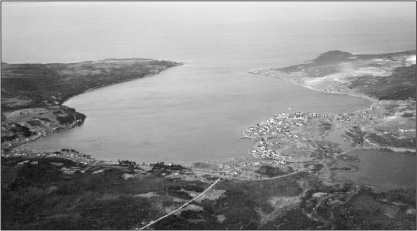
Hearts Content 1940. Courtesy Crown Lands Photo and Map Library, Province of Newfoundland and Labrador
Life at the cable station and its impact on an out-of-the-way fishing village is the focus of this book. The cable adventurers who came over from England to operate the station faced hardships of their own, but maintained their lifestyle and culture and developed a society alongside the outport way of life. In the process, they reshaped the educational, religious and social life of the community. They introduced leisure-time activities in music, art, drama and sport. At its peak the station employed over 200 skilled workers in a town of 1,500. For three generations it was a pivotal point in international communications and the focal point of Hearts Content, giving it a flavour and character all its own among the outports of Newfoundland.
Hearts Content today is a quiet place, its population hovering around 400. But go there and youll find a difference. Youll notice its large, comfortable harbour, more befitting a commercial shipping port than a modest fishing village. Youll see examples of Victorian architecture, rare in rural Newfoundland, and well-to-do housing from the 1920s. The cable station, now an historic site, remains the centrepiece of the town, where thousands of people come each summer to experience a piece of communications history. Here is the story of how it all came about.
A word about the notes, which I have used to document sources, not to supplement the text. Unless you are interested in checking the sources as you read, you can safely ignore the notes without fear of missing anything relevant to the story.
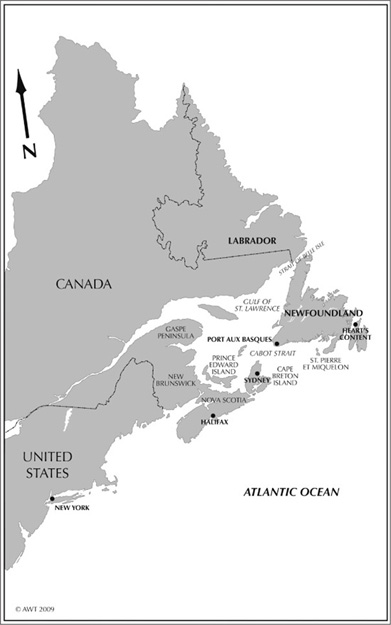
Atlantic Canada
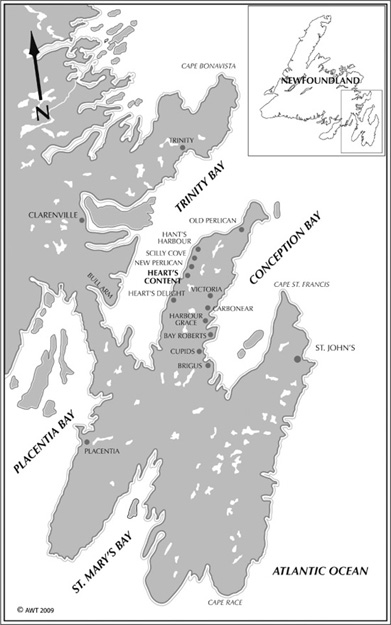
Avalon Peninsula and the East Coast of Newfoundland
Chapter 1
Frederic Gisborne, Cyrus Field and the Atlantic Cable of 1858
The middle of the nineteenth century was an exciting time to be alive. The world was evolving at a rapid clip as Western Europe and North America progressed through the new industrial age. Mechanization was boosting farm production. Manufacturing was replacing manual labour and, in the process, drawing people from the countryside to urban centers. London and New York struggled to keep up with the challenges of a bulging population. The steamship and the steam locomotive rewrote the rules of transportation, moving people from place to place at unprecedented speed, and delivering a wide variety of goods to new consumer markets. Inventions like the kitchen stove, the ice cooler, safety matches, the sewing machine and the gas lamp were within the reach of ordinary people. A series of Worlds Fairs, beginning with the London Exhibition of 1851, showcased the strides being made to millions of visitors. For the first time, individuals witnessed significant change within their own lifetimes, change that accelerated as the decades passed. It was an age infatuated with the concept of progress, glorifying science and industry for the lifestyle enhancements they brought.
Next page

